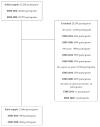Relationship between Depression and Physical Activity Frequency in Spanish People with Low, Medium, and High Pain Levels
- PMID: 39202046
- PMCID: PMC11355638
- DOI: 10.3390/jpm14080855
Relationship between Depression and Physical Activity Frequency in Spanish People with Low, Medium, and High Pain Levels
Abstract
Depression is a mental disorder that causes great discomfort, is associated with unhealthy lifestyle habits, and affects the quality of life. People with pain show high depressive symptoms and a prevalence of physical inactivity. This study aimed to analyse the associations between depression (self-reported depression, depression status, depressive symptoms, and depression types) and physical activity frequency (PAF) in leisure time in middle-aged and older people with different pain levels (low, medium, and severe) living in Spain. A cross-sectional study based on the European Health Survey data from Spain (2014-2020) was carried out, with a final sample of 13,686 people with pain. Associations between depression-related variables and PAF were studied at the three levels of pain, comparing the prevalence of depression as a function of PAF. Regression models were performed to assess adjusted risk factors for depression (self-reported depression and depression status). It was found that PAF was related to depression at all three pain levels. Inactive people at each pain level had higher depression prevalence (self-reported depression, depression status, depression symptoms, and depressive types). Physical inactivity emerged as a risk factor for depression, both for self-reported depression and for depression status. Thus, increased PAF could help prevent or reduce depression and depressive symptoms in people with pain.
Keywords: depression; exercise; mental health; psychological distress; quality of life.
Conflict of interest statement
The authors declare no conflicts of interest.
Figures






Similar articles
-
Quality of Life in European Adults and Older with All-Over Pain: Relationship with Frequency of Moderate and Vigorous Physical Activity and Decision Prediction Models with Cross-Sectional Data.Healthcare (Basel). 2025 May 17;13(10):1171. doi: 10.3390/healthcare13101171. Healthcare (Basel). 2025. PMID: 40428007 Free PMC article.
-
Relationships between Physical Activity Frequency and Self-Perceived Health, Self-Reported Depression, and Depressive Symptoms in Spanish Older Adults with Diabetes: A Cross-Sectional Study.Int J Environ Res Public Health. 2023 Feb 6;20(4):2857. doi: 10.3390/ijerph20042857. Int J Environ Res Public Health. 2023. PMID: 36833555 Free PMC article.
-
Frequency of physical activity during leisure time and variables related to pain and pain medication use in Spanish adults: A cross-sectional study.PLoS One. 2024 Nov 13;19(11):e0310685. doi: 10.1371/journal.pone.0310685. eCollection 2024. PLoS One. 2024. PMID: 39535981 Free PMC article.
-
Relationship Between Frequency of Physical Activity, Functional Mobility, and Self-Perceived Health in People with Different Levels of Pain: A Cross-Sectional Study.J Funct Morphol Kinesiol. 2024 Oct 21;9(4):198. doi: 10.3390/jfmk9040198. J Funct Morphol Kinesiol. 2024. PMID: 39449492 Free PMC article.
-
Behavioural modification interventions for medically unexplained symptoms in primary care: systematic reviews and economic evaluation.Health Technol Assess. 2020 Sep;24(46):1-490. doi: 10.3310/hta24460. Health Technol Assess. 2020. PMID: 32975190 Free PMC article.
Cited by
-
Quality of Life in European Adults and Older with All-Over Pain: Relationship with Frequency of Moderate and Vigorous Physical Activity and Decision Prediction Models with Cross-Sectional Data.Healthcare (Basel). 2025 May 17;13(10):1171. doi: 10.3390/healthcare13101171. Healthcare (Basel). 2025. PMID: 40428007 Free PMC article.
References
-
- Machado M.O., Veronese N., Sanches M., Stubbs B., Koyanagi A., Thompson T., Tzoulaki I., Solmi M., Vancampfort D., Schuch F.B., et al. The Association of Depression and All-Cause and Cause-Specific Mortality: An Umbrella Review of Systematic Reviews and Meta-Analyses. BMC Med. 2018;16:112. doi: 10.1186/s12916-018-1101-z. - DOI - PMC - PubMed
-
- World Health Organization Depressive Disorder (Depression) Key Facts 2023. [(accessed on 1 July 2024)]. Available online: https://www.who.int/news-room/fact-sheets/detail/depression.
LinkOut - more resources
Full Text Sources

